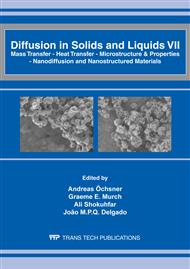p.668
p.674
p.682
p.690
p.696
p.702
p.708
p.713
p.719
Diffusion of Oxygen and Nitrogen in the Ti-15Mo Alloy Used for Biomedical Applications
Abstract:
The Ti-15Mo alloy is a promising material for use as a biomaterial because of its excellent corrosion resistance and its good combination of mechanical properties, such as fatigue, hardness, and wears resistance. This alloy has a body-centered predominantly cubic crystalline structure and the addition of interstitial atoms, such as oxygen and nitrogen, strongly alters its mechanical properties. Mechanical spectroscopy is a powerful tool to study the interaction of interstitial elements with the matrix metal or substitutional solutes, providing information such as the distribution and the concentration of interstitial elements. The objective of this paper is to study of the effects of heavy interstitial elements, such as oxygen and nitrogen, on the anelastic properties of the Ti-15Mo alloy by using mechanical spectroscopy measurements. In this study, the diffusion coefficients, pre-exponential factors, and activation energies were calculated for the oxygen in the Ti-15Mo alloy.
Info:
Periodical:
Pages:
696-701
Citation:
Online since:
April 2012
Keywords:
Price:
Сopyright:
© 2012 Trans Tech Publications Ltd. All Rights Reserved
Share:
Citation:


